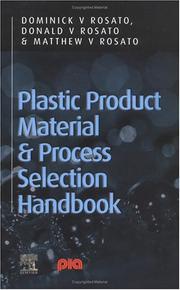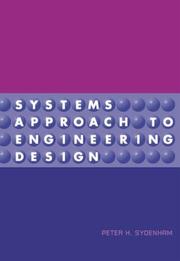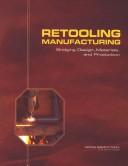| Listing 1 - 10 of 13 | << page >> |
Sort by
|

ISBN: 9781856174312 185617431X 9780080514055 0080514057 1281755036 9781281755032 9786611755034 Year: 2004 Publisher: Kidlington, Oxford, UK New York, USA Elsevier
Abstract | Keywords | Export | Availability | Bookmark
 Loading...
Loading...Choose an application
- Reference Manager
- EndNote
- RefWorks (Direct export to RefWorks)
This book is for people involved in working with plastic material and plastic fabricating processes. The information and data in this book are provided as a comparative guide to help in understanding the performance of plastics and in making the decisions that must be made when developing a logical approach to fabricating plastic products to meet performance requirements at the lowest costs. It is formatted to allow for easy reader access and this care has been translated into the individual chapter constructions and index. This book makes very clear the behaviour of the 35,000 different p
Plastics --- Engineering design --- Design, Engineering --- Engineering --- Industrial design --- Strains and stresses --- Design

ISBN: 158053774X 9781580537742 9781580534796 1580534791 Year: 2004 Publisher: Boston : [Piscataqay, New Jersey] : Artech House, IEEE Xplore,
Abstract | Keywords | Export | Availability | Bookmark
 Loading...
Loading...Choose an application
- Reference Manager
- EndNote
- RefWorks (Direct export to RefWorks)
Until now systems engineering methods have been the exclusive domain of large organizations employing hundreds of engineers to develop and deliver complex, tightly integrated systems designs. This book offers you a thorough and practical introduction to using systems engineering for managing your systems design projects. It empowers you with proven techniques that help you lead a small design team to world-class performance levels.
Engineering design. --- Systems engineering. --- Engineering systems --- System engineering --- Engineering --- Industrial engineering --- System analysis --- Design, Engineering --- Industrial design --- Strains and stresses --- Design and construction --- Design

ISBN: 0849311802 Year: 2004 Publisher: Boca Raton CRC
Abstract | Keywords | Export | Availability | Bookmark
 Loading...
Loading...Choose an application
- Reference Manager
- EndNote
- RefWorks (Direct export to RefWorks)
Engineering design --- Reliability (Engineering) --- Reliability of equipment --- Systems reliability --- Engineering --- Maintainability (Engineering) --- Probabilities --- Systems engineering --- Plant performance --- Safety factor in engineering --- Structural failures --- Design, Engineering --- Industrial design --- Strains and stresses --- Design
Book
ISBN: 0750657715 9780080473420 0080473423 9780750657716 6611002871 9786611002879 9781281002877 1281002879 Year: 2004 Publisher: Oxford : Butterworth-Heinemann,
Abstract | Keywords | Export | Availability | Bookmark
 Loading...
Loading...Choose an application
- Reference Manager
- EndNote
- RefWorks (Direct export to RefWorks)
This book introduces the subject of total design, and introduces the design and selection of various common mechanical engineering components and machine elements. These provide ""building blocks"", with which the engineer can practice his or her art.The approach adopted for defining design follows that developed by the SEED (Sharing Experience in Engineering Design) programme where design is viewed as ""the total activity necessary to provide a product or process to meet a market need."" Within this framework the book concentrates on developing detailed mechanical design skills in the
Machine elements --- Applied physical engineering --- Production management --- toegepaste mechanica --- ontwerpen --- machines --- machineonderdelen --- Engineering --- Mechanical Engineering --- Mechanical engineering. --- Engineering design. --- Conception technique. --- Génie mécanique. --- Design, Engineering --- Industrial design --- Strains and stresses --- Engineering, Mechanical --- Machinery --- Steam engineering --- Design
Periodical
Abstract | Keywords | Export | Availability | Bookmark
 Loading...
Loading...Choose an application
- Reference Manager
- EndNote
- RefWorks (Direct export to RefWorks)
Engineering design --- Mechanics, Applied --- Materials science --- Conception technique --- Mécanique appliquée --- Science des matériaux --- Engineering design. --- Materials science. --- Mechanics, Applied. --- Applied mechanics --- Engineering, Mechanical --- Material science --- Design, Engineering --- Engineering mathematics --- Physical sciences --- Industrial design --- Strains and stresses --- Civil Engineering --- Mechanical engineering --- Mechanical engineering. --- Engineering --- Machinery --- Steam engineering --- Chemistry --- Information Technology --- Life Sciences --- Physics --- Chemical Engineering --- General and Others --- Computer Aided Design & Production Control --- Biotechnology --- Mechanics

ISBN: 0131409190 Year: 2004 Publisher: Upper Saddle River, N.J. ; London : Pearson/Prentice Hall,
Abstract | Keywords | Export | Availability | Bookmark
 Loading...
Loading...Choose an application
- Reference Manager
- EndNote
- RefWorks (Direct export to RefWorks)
Engineering By Design introduces students to a broad range of important design topics. The engineering design process provides the skeletal structure for the text, around which is wrapped numerous cases that illustrate both successes and failures in engineering design. The text provides a balance of qualitative presentation of engineering practices that can be understood by students with little technical knowledge and a more quantitative approach in which substantive analytical techniques are used to develop and evaluate proposed engineering solutions. This flexibility means that the text can be used in a wide variety of courses. [Publisher]
621.8 --- Engineering design --- Design, Engineering --- Engineering --- Industrial design --- Strains and stresses --- Mechanical power transmission. Machine elements. Gearing. Materials handling. Fastening, fixing devices. Lubrication --- Design --- 621.8 Mechanical power transmission. Machine elements. Gearing. Materials handling. Fastening, fixing devices. Lubrication --- Engineering design. --- Conception technique.

ISBN: 1280175931 9786610175932 0309533414 9780309533416 0309092663 9780309092661 0309182255 Year: 2004 Publisher: Washington, DC : National Academies Press,
Abstract | Keywords | Export | Availability | Bookmark
 Loading...
Loading...Choose an application
- Reference Manager
- EndNote
- RefWorks (Direct export to RefWorks)
Manufacturing processes. --- Concurrent engineering. --- Systems engineering. --- Engineering design. --- Production engineering. --- Manufacturing engineering --- Process engineering --- Industrial engineering --- Mechanical engineering --- Design, Engineering --- Engineering --- Industrial design --- Strains and stresses --- Engineering systems --- System engineering --- System analysis --- Simultaneous engineering --- Industrial processing --- Manufacture --- Process engineering (Manufactures) --- Processes, Manufacturing --- Processing, Industrial --- Production processes --- Industrial arts --- Production engineering --- Machine-tools --- Materials --- Design --- Design and construction

ISBN: 9781402016097 1402016093 9781402026126 1402026129 Year: 2004 Publisher: New York : Kluwer Academic Publishers,
Abstract | Keywords | Export | Availability | Bookmark
 Loading...
Loading...Choose an application
- Reference Manager
- EndNote
- RefWorks (Direct export to RefWorks)
A vast majority of failures emanate from stress concentrators such as geometrical discontinuities. The role of stress concentration was first highlighted by Inglis (1912) who gives a stress concentration factor for an elliptical defect, and later by Neuber (1936). With the progress in computing, it is now possible to compute the real stress distribution at a notch tip. This distribution is not simple, but looks like pseudo-singularity as in principle the power dependence with distance remains. This distribution is governed by the notch stress intensity factor which is the basis of Notch Fracture Mechanics. Notch Fracture Mechanics is associated with the volumetric method which postulates that fracture requires a physical volume. Since fatigue also needs a physical process volume, Notch Fracture Mechanics can easily be extended to fatigue emanating from a stress concentration.
Notch effect --- Stress concentration --- Notch effect. --- Stress concentration. --- Civil engineering. --- Engineering. --- Engineering design. --- Mechanical engineering. --- Mechanics. --- Chemical & Materials Engineering --- Engineering & Applied Sciences --- Materials Science --- Structural mechanics. --- Mechanical Engineering. --- Structural Mechanics. --- Civil Engineering. --- Engineering Design. --- Mechanics, Applied. --- Solid Mechanics. --- Classical Mechanics. --- Design, Engineering --- Engineering --- Industrial design --- Strains and stresses --- Public works --- Applied mechanics --- Engineering, Mechanical --- Engineering mathematics --- Classical mechanics --- Newtonian mechanics --- Physics --- Dynamics --- Quantum theory --- Machinery --- Steam engineering --- Design

ISBN: 0387228993 0387228349 Year: 2004 Publisher: New York, New York : Springer,
Abstract | Keywords | Export | Availability | Bookmark
 Loading...
Loading...Choose an application
- Reference Manager
- EndNote
- RefWorks (Direct export to RefWorks)
The Verilog Hardware Description Language was first introduced in 1984. Over the 20 year history of Verilog, every Verilog engineer has developed his own personal “bag of tricks” for coding with Verilog. These tricks enable modeling or verifying designs more easily and more accurately. Developing this bag of tricks is often based on years of trial and error. Through experience, engineers learn that one specific coding style works best in some circumstances, while in another situation, a different coding style is best. As with any high-level language, Verilog often provides engineers several ways to accomplish a specific task. Wouldn’t it be wonderful if an engineer first learning Verilog could start with another engineer’s bag of tricks, without having to go through years of trial and error to decide which style is best for which circumstance? That is where this book becomes an invaluable resource. The book presents dozens of Verilog tricks of the trade on how to best use the Verilog HDL for modeling designs at various level of abstraction, and for writing test benches to verify designs. The book not only shows the correct ways of using Verilog for different situations, it also presents alternate styles, and discusses the pros and cons of these styles.
Verilog (Computer hardware description language) --- Application-specific integrated circuits --- Design. --- Systems engineering. --- Computer science. --- Engineering design. --- Circuits and Systems. --- Programming Languages, Compilers, Interpreters. --- Engineering Design. --- Electronic circuits. --- Programming languages (Electronic computers). --- Design, Engineering --- Engineering --- Industrial design --- Strains and stresses --- Computer languages --- Computer program languages --- Computer programming languages --- Machine language --- Electronic data processing --- Languages, Artificial --- Electron-tube circuits --- Electric circuits --- Electron tubes --- Electronics --- Design --- Design and construction.

ISBN: 1402028482 1402028490 1475710577 9781402028496 9781402028489 Year: 2004 Volume: 841 Publisher: Boston (Mass.) : Kluwer academic,
Abstract | Keywords | Export | Availability | Bookmark
 Loading...
Loading...Choose an application
- Reference Manager
- EndNote
- RefWorks (Direct export to RefWorks)
1. 1 Power-dissipation trends in CMOS circuits Shrinking device geometry, growing chip area and increased data-processing speed performance are technological trends in the integrated circuit industry to enlarge chip functionality. Already in 1965 Gordon Moore predicted that the total number of devices on a chip would double every year until the 1970s and every 24 months in the 1980s. This prediction is widely known as "Moore's Law" and eventually culminated in the Semiconductor Industry Association (SIA) technology road map [1]. The SIA road map has been a guide for the in dustry leading them to continued wafer and die size growth, increased transistor density and operating frequencies, and defect density reduction. To mention a few numbers; the die size increased 7% per year, the smallest feature sizes decreased 30% and the operating frequencies doubled every two years. As a consequence of these trends both the number of transistors and the power dissi pation per unit area increase. In the near future the maximum power dissipation per unit area will be reached. Down-scaling of the supply voltage is not only the most effective way to reduce power dissipation in general it also is a necessary precondition to ensure device reliability by reducing electrical fields and device temperature, to prevent device degradation. A draw-back of this solution is an increased signal propa gation delay, which results in a lower data-processing speed performance.
Electrical & Computer Engineering --- Engineering & Applied Sciences --- Electrical Engineering --- Digital electronics. --- Metal oxide semiconductors, Complementary. --- Electrical engineering. --- Engineering design. --- Computers. --- Electronics. --- Microelectronics. --- Electrical Engineering. --- Engineering Design. --- Theory of Computation. --- Electronics and Microelectronics, Instrumentation. --- Microminiature electronic equipment --- Microminiaturization (Electronics) --- Electronics --- Microtechnology --- Semiconductors --- Miniature electronic equipment --- Electrical engineering --- Physical sciences --- Automatic computers --- Automatic data processors --- Computer hardware --- Computing machines (Computers) --- Electronic brains --- Electronic calculating-machines --- Electronic computers --- Hardware, Computer --- Computer systems --- Cybernetics --- Machine theory --- Calculators --- Cyberspace --- Design, Engineering --- Engineering --- Industrial design --- Strains and stresses --- Electric engineering --- Design
| Listing 1 - 10 of 13 | << page >> |
Sort by
|

 Search
Search Feedback
Feedback About
About Help
Help News
News